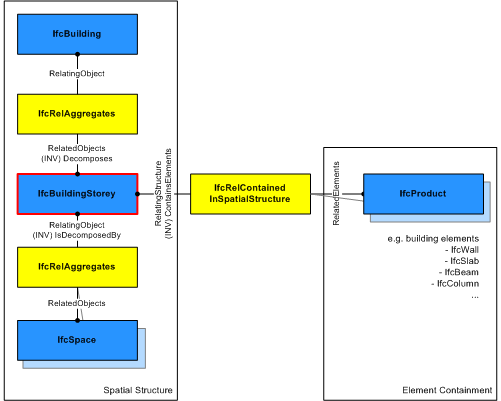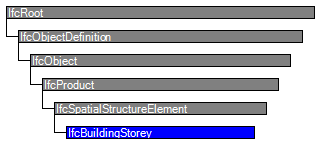Semantic definitions at the entity
Entity definition
The building storey has an elevation and typically represents a (nearly) horizontal aggregation of spaces that are vertically bound.
A storey is (if specified) associated to a building. A storey may span over several connected storeys. Therefore storey complex provides for a collection of storeys included in a building. A storey can also be decomposed in (horizontal) parts, where each part defines a partial storey. This is defined by the composition type attribute of the supertype IfcSpatialStructureElements which is interpreted as follow:
- COMPLEX = building storey complex
- ELEMENT = building storey
- PARTIAL = partial building storey
EXAMPLE: In split level houses, a storey is split into two or more partial storeys, each with a different elevation. It can be handled by defining a storey, which includes two or more partial storeys with the individual elevations.
HISTORY New entity in IFC Release 1.0
Property Set Use Definition
The property sets relating to the IfcBuildingStorey are defined by the IfcPropertySet and attached by the IfcRelDefinesByProperties relationship. It is accessible by the inverse IsDefinedBy relationship. The following property set definitions specific to the IfcBuildingStorey are part of this IFC release:
- Pset_BuildingStoreyCommon: common property set for all types of building stories
Quantity Use Definition
The quantities relating to the building storey are defined by the IfcElementQuantity and attached by the IfcRelDefinesByProperties. The following quantities are foreseen, but will be subjected to the local standard of measurement:
| Name | Description | Value Type |
| NominalHeight | Standard height of this storey, from the bottom surface of the floor, to the bottom surface of the floor or roof above. The exact definition and calculation rules depend on the method of measurement used. | IfcQuantityLength |
| GrossFloorArea | Calculated sum of all areas covered by the building storey (as horizontal projections and normally including the area of construction elements. The exact definition and calculation rules depend on the method of measurement used. | IfcQuantityArea |
| NetFloorArea | Calculated sum of all usable areas covered by the building storey (normally excluding the area of construction elements). The exact definition and calculation rules depend on the method of measurement used. | IfcQuantityArea |
| GrossVolume | Calculated gross volume of all areas enclosed by the building storey (normally including the area of construction elements). The exact definition and calculation rules depend on the method of measurement used. | IfcQuantityVolume |
| NetVolume | Calculated net volume of all areas enclosed by the building storey (normally excluding the area of construction elements). The exact definition and calculation rules depend on the method of measurement used. | IfcQuantityVolume |
Spatial Structure Use Definition
The IfcBuildingStorey is used to build the spatial structure of a building (that serves as the primary project breakdown and is required to be hierarchical). The spatial structure elements are linked together by using the objectified relationship IfcRelAggregates. The IfcBuildingStoreyreferences them by its inverse relationships:
- IfcBuildingStorey.Decomposes -- referencing (IfcBuilding || IfcBuildingStorey) by IfcRelAggregates.RelatingObject, If it refers to another instance of IfcBuildingStorey, the referenced IfcBuildingStorey needs to have a different and higher CompositionType, i.e. COMPLEX (if the other IfcBuildingStorey has ELEMENT), or ELEMENT (if the other IfcBuildingStorey has PARTIAL).
- IfcBuildingStorey.IsDecomposedBy -- referencing (IfcBuildingStorey || IfcSpace) by IfcRelAggregates.RelatedObjects. If it refers to another instance of IfcBuildingStorey, the referenced IfcBuildingStorey needs to have a different and lower CompositionType, i.e. ELEMENT (if the other IfcBuildingStorey has COMPLEX), or PARTIAL (if the other IfcBuildingStorey has ELEMENT).
- IfcBuildingStorey.ContainsElements -- referencing any subtype of IfcProduct (with the exception of other spatial structure element) by IfcRelContainedInSpatialStructure.RelatedElements.

|
Figure shows the IfcBuildingStorey as part of the spatial structure. It also serves as the spatial container for building and other elements. |
Geometry Use Definitions
The geometric representation of IfcBuildingStorey is given by the IfcProductDefinitionShape and IfcLocalPlacement, allowing multiple geometric representation.
Local Placement
The local placement for IfcBuildingStorey is defined in its supertype IfcProduct. It is defined by the IfcLocalPlacement, which defines the local coordinate system that is referenced by all geometric representations.
- The PlacementRelTo relationship of IfcLocalPlacement shall point (if relative placement is used) to the IfcSpatialStructureElement of type IfcBuilding, or of type IfcBuildingStorey (e.g. to position a building storey relative to a building storey complex, or a partial building storey to a building storey).
- If the relative placement is not used, the absolute placement is defined within the world coordinate system.
Geometric Representations
Currently, the use of a 2D 'FootPrint' representation of type 'GeometricCurveSet' and a 3D 'Body' representation of type 'Brep' is supported.
NOTE The independent geometric representation of IfcBuildingStorey may not be required or allowed in certain view definitions. In those cases only the contained elements and spaces have an independent geometric representation.
Foot Print Representation
The foot print representation of IfcBuildingStorey is given by either a single 2D curve (such as IfcPolyline or IfcCompositeCurve), or by a list of 2D curves (in case of inner boundaries), if the building storey has an independent geometric representation.
The representation identifier and type of this geometric representation of IfcBuildingStorey is:
- IfcShapeRepresentation.RepresentationIdentifier = 'FootPrint'
- IfcShapeRepresentation.RepresentationType = 'GeometricCurveSet'
Body Representation
The body (or solid model) geometric representation (if the building storey has an independent geometric representation) of IfcBuildingStorey is defined using faceted B-Rep capabilities (with or without voids), based on the IfcFacetedBrep or on the IfcFacetedBrepWithVoids.
The representation identifier and type of this representation of IfcBuildingStorey is:
- IfcShapeRepresentation.RepresentationIdentifier = 'Body'
- IfcShapeRepresentation.RepresentationType = 'Brep'
Since the building storey shape is usually described by the exterior building elements, an independent shape representation shall only be given, if the building storey is exposed independently from its constituting elements.
Attribute definitions
| # | Attribute | Type | Cardinality | Description | A |
|---|---|---|---|---|---|
| 10 | Elevation | - | This attribute is out of scope for this model view definition and shall not be set. |

 Instance diagram
Instance diagram Link to this page
Link to this page